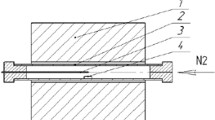Abstract
The role of evaporation and dispersion in the formation of smelting dust is considered. A mathematical model is proposed for the evaporative generation of dust when working molten metal. It is compared with experimental data. The main factor affecting the mass of dust formed and the dimension of the dust particles is the surface temperature of the melt. Increase in that temperature increases dust emission, and the particle diameter is greater. The size of the smelting-dust particles is considerably increased on coagulation: at liquid drops or in electrostatic, magnetic, and acoustic fields.
Similar content being viewed by others
References
Beker L.A. and Ward R.C. Reaction of an iron-carbon droplet during free all through oxygen, J. Iron Steel Inst., London, 1967, no. 7, pp. 741–747.
Kravets, V.A. and Petrenko, S.S., Influence of the neutral- gas supply on the aerodynamics of emissions when filling the ladle with hot metal, Izv. Vyssh. Uchebn. Zaved., Chern. Metall., 2001, no. 1, pp. 26–29.
Simonyan, L.M. and Govorova, N.M., Features of dust formation in the oxygen-blowing of melts and possible uses of captured dust, Metallurgist, 2011, vol. 55, no. 6, p. 450.
Andon’ev, S.M. and Filip’ev, O.V., Pylegazovye vybrosy predpriyatii chernoi metallurgii (Dust Gaseous Emissions of the Ferrous Metallurgy), Moscow: Metallurgiya, 1973.
Butorina, I.V., Influence of silicon on smelting-dust formation, Stal’, 2011, vol. 41, no. 1, p. 80.
Butorina, I.V. and Emel’yanova, E.S., Formation and reduction of dust emission in ferroalloy production industry, Chern. Met., 2012, no. 3, pp. 21–25.
Ryzhonkov, D.I., Arsen’ev, P.P., Yakovlev, V.V., et al., Teoriya metallurgicheskikh protsessov: uchebnik dlya vuzov (The Theory of Metallurgical Processes: Manual for Higher Education Institutions), Moscow: Metallurgiya, 1989.
Nesmeyanov, A.N., Davlenie para khimicheskikh elementov (The Pressure of Vapor Containing the Chemical Elements), Moscow: Akad. Nauk SSSR, 1961.
Raist, P., Introduction to Aerosol Science, New York: Macmillan, 1984.
Fuks, N.A., Isparenie i rost kapel’ v gazoobraznoi srede (Evaporation and Growth of Droplets in a Gaseous Medium), Moscow: Akad. Nauk SSSR, 1958.
Author information
Authors and Affiliations
Corresponding author
Additional information
Original Russian Text © I.V. Butorina, E.S. Fedotova, 2016, published in Stal’, 2016, No. 6, pp. 90–94.
About this article
Cite this article
Butorina, I.V., Fedotova, E.S. Role of evaporation in the formation of smelting dust. Steel Transl. 46, 447–452 (2016). https://doi.org/10.3103/S0967091216060024
Received:
Published:
Issue Date:
DOI: https://doi.org/10.3103/S0967091216060024




